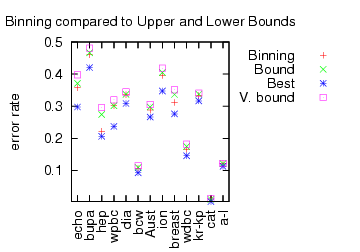An argument is sometimes made that the Bayesian way is the “right” way to do machine learning. This is a serious argument which deserves a serious reply. The approximation argument is a serious reply for which I have not yet seen a reply2.
The idea for the Bayesian approach is quite simple, elegant, and general. Essentially, you first specify a prior P(D) over possible processes D producing the data, observe the data, then condition on the data according to Bayes law to construct a posterior:
After this, hard decisions are made (such as “turn left” or “turn right”) by choosing the one which minimizes the expected (with respect to the posterior) loss.
This basic idea is reused thousands of times with various choices of P(D) and loss functions which is unsurprising given the many nice properties:
- There is an extremely strong associated guarantee: If the actual distribution generating the data is drawn from P(D) there is no better method. One way to think about this is that in the Bayesian setting, the worst case analysis is the average case analysis.
- The Bayesian method is a straightforward extension of the engineering method for designing a solution to a problem.
- The Bayesian method is modular. The three information sources are prior P(D), data x, and loss, but loss only interacts with P(D) and x via the posterior P(D|x).
The fly in the ointment is approximation. The basic claim of the approximation argument is that approximation is unavoidable in all real-world problems that we care about. There are several ways in which approximation necessarily invades applications of Bayes Law.
- When specifying the prior, the number of bits needed to describe the “real” P(D) is typically too large. The meaning of “real” P(D) actually varies, but this statement appears to hold true across all of them. What happens instead is that people take short-cuts specifying something which isn’t quite the real prior.
- Even if the real P(D) is somehow specifiable, computing the posterior P(D|x) is often computationally intractable. Again, the common short-cut is to alter the prior so as to make it computationally tractable. (There are a few people who instead attempt to approximately compute the posterior via monte carlo methods.)
Consider for example the problem of speech recognition. A “real” prior P(D) (according to some definitions) might involve a distribution over the placement of air molecules, the shape of the throat producing the sound, and what is being pronounced. This prior might be both inarticulable (prior elicitation is nontrivial) and unrepresentable (because too many bits are required to store on a modern machine).
If the necessity of approximation is accepted, the question becomes “what do you do about it?” There are many answers:
- Ignore the problem. This works well sometimes but can not be a universal prescription.
- Avoid approximation and work (or at least work a computer) very hard. This also can work well, at least for some problems.
- Use an approximate Bayesian method and leave a test set on the side to sanity check results. This is a common practical approach.
- Violate the modularity of loss and attempt to minimize approximation errors near the decision boundary. There seems to be little deep understanding of the viability and universality of this approach but there are examples where this approach can provide significant benefits.
Some non-Bayesian approaches can be thought of as attempts at (4).

